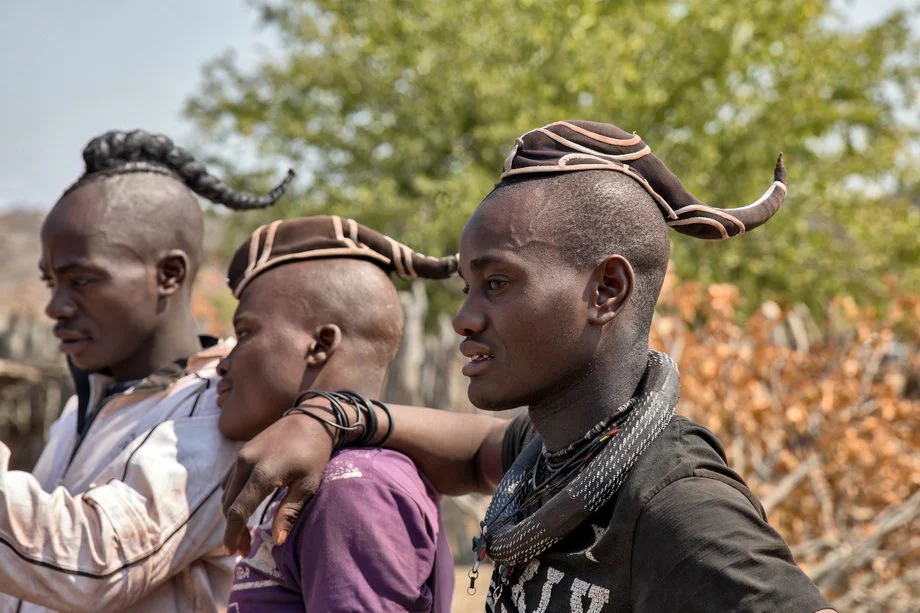Nestled in the arid region of northern Namibia, the Himba people stand as one of Africa’s most resilient and culturally preserved tribes. The Himba are semi-nomadic pastoralists, largely untouched by modern influences, and they maintain customs and practices that stretch back centuries. Among their most recognizable and startling traditions is the use of red ochre by women to coat their skin and hair—a practice that goes beyond aesthetics, embedding itself into the very fabric of their social, cultural, and spiritual lives. This article delves into the ancient customs of the Himba, exploring how they preserve their identity in a rapidly changing world.
The Symbolism of Red Ochre: Beauty, Protection, and Identity
One of the first things that stand out about the Himba women is their striking appearance, particularly their reddish skin. This is achieved by applying a mixture of butterfat and red ochre—locally called “otjize”—which they rub on their bodies and hair daily. While the ochre may seem like a cosmetic choice to outsiders, it holds far deeper significance for the Himba.
Traditionally, the otjize is a marker of beauty, and women consider the red hue to symbolize the earth, blood, and life itself. It’s also practical. The harsh sun and dry climate of northern Namibia can be unforgiving, and the otjize helps protect their skin from the sun’s ultraviolet rays and insect bites. Moreover, in a symbolic sense, it connects them to the earth and their ancestors. To a Himba woman, the ochre is much more than a beauty product; it is a vital link to her cultural identity and heritage.
Intricate Hair Sculpting: A Language of Status and Role
Another fascinating aspect of Himba culture is their intricate hairstyles, which are far from mere decoration. For the Himba, hair is a language—each style and braid signifies the individual’s age, social status, and marital state. For instance, young girls wear their hair in simple braids, while married women adorn their heads with elaborate designs coated in otjize and decorated with ornaments.
When a Himba boy transitions into manhood, his hair is cut except for a single plait on the crown of his head, symbolizing his status as eligible for marriage. Similarly, when a woman marries, her hair is styled in a crown-like structure that identifies her as a wife. This system of hairstyles serves not only as a marker of identity but also as a way of navigating social relationships within the tribe.
Polygamy and the Complexities of Marriage
Polygamy is another core aspect of Himba society. Himba men are allowed to have multiple wives, and marriage is typically arranged by the families, sometimes when the children are still young. Himba women often find themselves sharing their husband with other wives, and although this might seem shocking to outsiders, it’s a normalized aspect of their culture.
This system is rooted in practicality. The Himba rely heavily on livestock, and more wives mean more hands to tend to the animals and the household. However, within this structure, Himba women maintain significant autonomy. They are responsible for managing their homes and children and often have authority within their extended families.
Challenges of Modernization: Preservation vs. Change
The Himba way of life, though deeply rooted in tradition, is not immune to the pressures of modernization. Namibia’s infrastructure, economy, and tourism have slowly encroached on the Himba’s semi-nomadic lifestyle. Schools, clinics, and modern amenities are becoming more accessible, tempting younger generations to abandon their ancestral practices in favor of more contemporary ways of living.
Tourism presents both a blessing and a challenge. While some Himba benefit economically from the influx of visitors, others argue that it commodifies their culture, turning their sacred traditions into mere spectacles for tourists. This tension raises difficult questions about how much of their culture the Himba can hold on to in the face of inevitable change.
Conclusion: A Tribe Standing at the Crossroads
Despite the encroaching forces of modernization, the Himba people have managed to preserve much of their unique cultural heritage. Their striking red ochre, intricate hairstyles, and polygamous marriage customs offer a window into a way of life that has remained largely unchanged for centuries. However, the future of the Himba culture is at a crossroads, as external influences begin to alter the fabric of their society. Whether they adapt or hold steadfast to their traditions, the Himba people stand as a testament to the enduring power of cultural identity in an increasingly globalized world.























